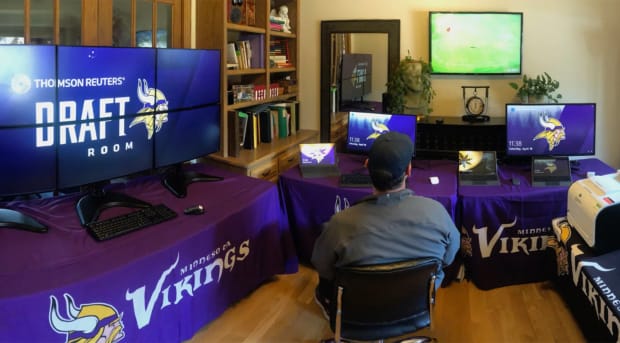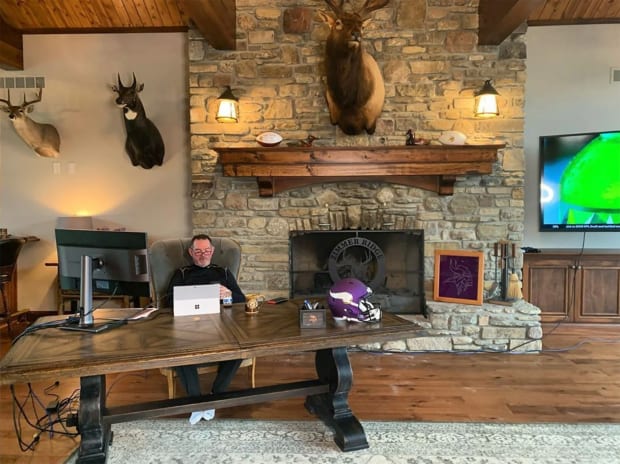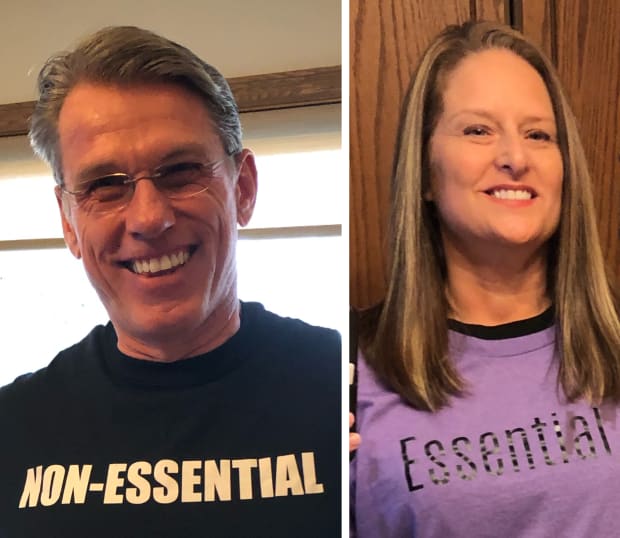New on Sports Illustrated: Behind the Scenes of the Vikings Draft: A Record 15 Picks, Dozens of Locations, and Zero Glitches
With a franchise-record number of selections in a crucial offseason, the Vikings needed everything to go right—and not just with the players getting picked before them. How the board came to the Vikings, and how the—essential—tech staff that made it all work.
As the first round of a historic NFL draft unspooled Thursday, top members of the Vikings’ IT team grew as nervous as general manager Rick Spielman. That’s not an exaggeration. They understood that years of planning and a month of emergency reconfigurations had come down to three days that promised a binary outcome of technological triumph or disaster. And they knew that they needed to connect upwards of 30 employees via videoconference in order to make a record number of selections remotely. And they understood that their future hinged on eliminating hiccups.
They also realized the duality present in Spielman’s technological proficiency. Sure, the GM had embraced their value, tasking both groups with building out an organization-wide IT infrastructure from scratch by when the franchise opened its palatial new headquarters in 2018. But Spielman also tends to regularly break phones, tablets and programs, like some kind of tech jinx. It left his IT staff to configure an if-you-build-it-he-can’t-break-it system before the draft.
Hours passed before the Vikings’ first selection, at pick No. 22, approached on Thursday. This gave Spielman ample time to crash something and commentators ample opportunity to remind viewers that Minnesota had traded talented wideout Stefon Diggs to Buffalo this spring and lost several key defensive players (end Everson Griffen, tackle Linval Joseph, and three of its top four cornerbacks in Trae Waynes, Xavier Rhodes and Mackensie Alexander) in free agency. The same commentators pointed out that, while Spielman retained a strong young core, he needed to complete a significant roster makeover this draft. Which is why Spielman turned 12 picks into 17 selections
that became 15 players (and more picks next year) by the time the draft ended on Saturday afternoon.The latest Vikings haul represented the largest class since the NFL condensed its annual draft to seven rounds in 1994. It also marked Minnesota’s first 15-member class since ’85 and largest-overall draft class since ’76, when the team added 17 players—over 17 rounds. How did the Vikings pull that off? Well …
* * *
Everything You Need to Know About the NFL Draft: Sign up for Sports Illustrated’s newsletters and get complete NFL Draft coverage and analysis—delivered right to your inbox.
* * *
The preparations actually began last spring, unknowingly, when Cheryl Nygaard (information technology director) and Paul Nelson (information systems director) and their employees put together a business continuity plan. This report examined the infrastructure already in place, while planning for upgrades and improvements over the next five years. It even had a section on how the Vikings would handle a natural disaster, should some event occur that would force the entire organization to function remotely.
Like, well, a global pandemic.
When the novel coronavirus shut down the sports world in mid-March, the Vikings were more ready than most, and they moved quickly to implement creative solutions. At first, they shifted their draft operation into an empty office building nearby their facility. But then Tim Walz, the state’s governor, shut down access to those types of buildings.
The Vikings then uncovered another loophole upon discovering that their state considered a hotel a residence, meaning they could move everything from the office park into the J.W. Marriott at the Mall of America. They did that, setting up different ballrooms and meeting spaces for various scouting or position groups in order to follow health guidelines like social distancing and keep their total group sizes under 10. They planned to prep for and conduct the draft there, until the NFL told all its teams they needed to stay home instead.
Still, Spielman is a GM who’s so thorough his notes look like complex mathematical equations, so he decided to stay for the month before the draft in the J.W. anyway. He didn’t want to take even a small chance he might get sick. He was one of three total guests and therefore had his own personal makeshift concierge team—his now-close friends Beto, Zach and Marcus, who satiated Spielman with custom smoothies and bacon-beef-peanut-butter sliders as he prepared for his most critical draft in years.
While Spielman added to his tally of more than three million Marriott points, his IT dream team reconfigured its draft machine once again. This time, they used the home office of his wife, Michele, moving her Peloton set up to make room for his virtual draft one. As co-chair of the league’s general manager committee, Spielman says “everybody was leery we were not going to be able to operate like normal.” But he saw his IT group as a competitive advantage. He would be at worst no less ready than any of his counterparts. He would be more prepared, he believed, than many of them.

The IT folks watched curiously during the draft when they saw general manager set ups with little equipment (like for Giants GM Dave Gettleman, who sat next to stacks of books and binders) or lots of screens (Rams GM Les Snead had 13 crammed into a guest bedroom). The Vikings had considered all options, before settling on an approach between extremes. CenturyLink installed a second internet hub at the Spielman house for redundancy, in case either one had a service issue, along with two analog phone lines; one for team calls and another for league ones. The Vikings also set up a generator just outside the office, in case the electricity went out.
Then Nelson went to work. He had already built an enviable interactive draft board at the new facility, stitching together dozens of 50-inch flatscreens on the wall in the war room. Spielman liked to show off the interface to visitors, toggling between position groups, comparing corners relative to other corners; or gauging them in terms of overall value; or separating them by grades. This became his stock ticker of prospect evaluation, a monument to the Vikings’ emphasis on technology. As Nelson wondered how he might recreate that in another location, he glanced at the wall in his office and noticed the prototype that had been built for the original board, a wall of six 27-inch screens with 4K picture quality. Voila. He had Spielman’s interactive home draft board.
While Nelson began his installation, Nygaard tackled the issue of how the Vikings would communicate throughout the draft. They added equipment in his house to help push multiple video conferences at once at the highest possible speeds. Spielman would be on one conference with his owners and top lieutenants, working through things like trades; there would be a main draft room, with scouts and assistant coaches; there would be other conferences set up by position, that scouts, coaches and executives could hop in and out of (and in an app the Vikings had created); and there would another league group of NFL personnel executives. “The only issue at that point,” says Rob Brzezinski, a top Spielman lieutenant and resident salary cap expert, “was that Rick’s wife had to actually deal with him.”
It fell to Spielman to toggle between the screens and to Nygaard to update the rest of the groups on his progress throughout the draft. As Spielman changed grades, or the needs of other teams in real time on his interactive board, everyone else could see the changes that he made, also in real time. The IT team had created a second app that put every other NFL GM on speed dial, meaning Spielman needed only two clicks to call any of his counterparts. It helped that the GM, coach Mike Zimmer and many of the team’s top personnel folks like Brzezinski and assistant GM George Paton have been together forever. “You can’t undervalue the continuity and familiarity between our scouting staff and coaching staff,” says Mark Wilf, the team’s owner. “Our scouts are very familiar with the type of players Mike and his coaches are looking for, and that foundation of knowledge and comfort was instrumental in navigating this.”
Spielman actually seemed relaxed when he held a videoconference with reporters before the draft from his home office. “They’re all muted, Bob,” he said, to the Vikings PR chief, Bob Hagan, gesturing at the reporters on their screens. “This is great! Zim would love this!” He said he worried about how trades would work, should any glitches arise. He noted the depth at wide receiver in the draft, the number of defenders that had left Minnesota, the total picks and the roster reshaping that could be done, if all fell right. All of which set up the nerves on Thursday, as teams began to make their first-round picks.
* * *
* * *
Spielman struggled most with the toggling; at one point, he wondered why Brzezinski, clad in a purple, Prince, Vikings jersey (symbol included!), continued to eat while Spielman spoke directly to him. The GM didn’t realize he had muted the wrong video conference. “When I hit the un-mute button, his nachos went flying everywhere,” Spielman says with a laugh. (Brzezinski also chuckles at the anecdote, saying he thinks it was actually a slice of pizza, plus he wore a poncho for Day 2.)
Otherwise, everything did fall right, from both a draft perspective and a technological one. Minnesota experienced no issues when it looked into trading up in the first round. The Vikings ultimately stayed put and still managed to land LSU wideout Justin Jefferson at 22. While he was the fifth wideout taken, this was an unusually deep class at that position. In many, more typical drafts, scouts said Jefferson—who set a school record with 111 catches for a national champion last season—would have been the top wideout on the board. (The Vikings also liked receiver Jalen Reagor from TCU, who went the pick before to Philadelphia.) Regardless, Minnesota felt fortunate to land a replacement for Diggs immediately, allowing for flexibility moving forward.
“We were sweating that out the whole time, hoping you would get to us,” Zimmer told Jefferson over video conference after the Vikings made the pick. Like viewers across the country, Spielman noticed the mounted deer heads hanging on the wall behind his coach. He joked that Zimmer had bought them at Kmart the week before.

Spielman put that flexibility to immediate use. When the 49ers called about the Vikings other first-rounder, the 25th overall selection, and offered a fourth- and fifth-rounder to move up six slots, Spielman scanned the teams picking between 26 and 30. He wanted TCU cornerback Jeff Gladney, a player so tough he ran the 40-yard dash at the Combine with a torn meniscus—and still ran a 4.48. Spielman felt comfortable with the level of risk involved, made the trade, banked two additional third-day picks and still landed Gladney later in the first round.
By taking an elite receiver and top corner on Day 1, Spielman was able to draft an offensive lineman, Ezra Cleveland from Boise State, in the second round. The early stages of the draft had gone exactly as he’d hoped, and the trades he also made had netted 13 additional picks for Day 3 alone. “The way it fell this year, the board fell to us,” he says. “Other years, it doesn’t.”
As the draft continued, glitch-free, Spielman continued to reshape his roster around his core. He addressed his lack of corner depth with two of his first four selections and his eighth. He took team captains from major schools. He nabbed players from rival universities (Michigan and Michigan State, Oregon and Oregon State) and players from the SEC and Pac-12 and Big-12 and even Washburn. He took a developmental quarterback in Iowa’s Nate Stanley. He grabbed three linemen. And, given his number of defensive departures, he spent nine of 15 selections on that side of the ball, adding three defensive linemen for position coach (and new co-defensive coordinator) Andre Patterson, who Zimmer has long lauded as one of the NFL’s best at developing players.
The GM says he accumulated the high tally of sixth- and seventh-round picks on purpose, because he was worried about how the typical scramble for college free agents would unfold in a virtual draft scenario. He ended up using six of those selections, without having to bid against other teams. In the case of Michigan State defensive end Kenny Willekes, Spielman was able to remove the uncertainty and nab the player he coveted with a seventh-rounder he had obtained. Then Minnesota signed Texas A&M receiver Quartney Davis, a player they didn’t draft in part because of the staggering depth at that position.
Overall, the virtual draft system actually proved more efficient than the old one. Scouts sent the IT folks congratulatory texts afterward. Fantastic, they read. Didn’t miss a beat.
Spielman believes some of his team’s draft changes will stick. The free-agent rush in particular worked more smoothly in years past, because of the in-house app that Nelson had developed, without coaches and scouts running through hallways, screaming into phones. Each position group had its own videoconference room so that scouts, executives and coaches could pop in and out. The Vikings will also likely hold many of their draft meetings via videoconference moving forward, rather than fly everyone in (which they’ll do for their main draft prep in April).
Most pundits placed the Vikings among their draft “winners,” or graded Spielman with As and A-s. The only move he failed to pull off over the weekend was a trade with Washington for offensive tackle Trent Williams, who went to San Francisco. Otherwise, perfect—and Spielman knew exactly who to credit beyond the usual folks, like his coaches and his scouts. “You rarely hear about the work that the IT department does,” Spielman says. “But to me, they were the heroes of this draft.”
To that end, the GM laughs when he notes that his IT workers were considered essential employees by the state, while he, the general manager, the person in charge of making all the picks, was not. Nygaard even had a little fun with that notion, making T-shirts for the draft. Her purple shirt read: ESSENTIAL (followed by a colorful descriptor). His black shirt with white letters? It had NON-ESSENTIAL splashed across the front.

As Spielman detailed the Vikings draft on Sunday, tech workers moved throughout the background, breaking down his set up. His wife needed her office back and had given him a deadline of that evening to clear out. His daughter, Whitney, one of six children the Spielmans have adopted, had told him, “Dad, I’m famous,” after 28 friends had sent her text messages saying they had seen her on TV.
The Vikings would begin their virtual off-season program on Monday, meaning no rest for the IT folks. Having so many new players cut both ways for Spielman, who described development as the strength of his coaching staff but acknowledged that his new players won’t have as many practices with the coaches who can develop them, at least not in the near term. Several of his rookies will have to play immediately, giving paramount importance to whatever time they do spend with their coaches.
As Spielman began to assess the Vikings’ future, he was comforted in not only his 15 new players but also the 12 picks he had collected for the 2021 draft. When he looked back at the weekend that was, he remembered only one significant glitch. After all the prep and all the installations and all the picks and all the trades, he had gone to log on to the team’s virtual draft party, at which point … his internet went out.
Comments
Post a Comment